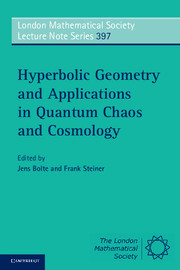Book contents
- Frontmatter
- Contents
- List of Contributors
- Preface
- I Hyperbolic Geometry
- II Selberg's Trace Formula: An Introduction
- III Semiclassical Approach to Spectral Correlation Functions
- IV Transfer Operators, the Selberg Zeta Function and the Lewis-Zagier Theory of Period Functions
- V On the Calculation of Maass Cusp Forms
- VI Maass Waveforms on (Γ0(N), χ) (Computational Aspects)
- VII Numerical Computation of Maass Waveforms and an Application to Cosmology
- Index
- References
IV - Transfer Operators, the Selberg Zeta Function and the Lewis-Zagier Theory of Period Functions
Published online by Cambridge University Press: 05 January 2012
- Frontmatter
- Contents
- List of Contributors
- Preface
- I Hyperbolic Geometry
- II Selberg's Trace Formula: An Introduction
- III Semiclassical Approach to Spectral Correlation Functions
- IV Transfer Operators, the Selberg Zeta Function and the Lewis-Zagier Theory of Period Functions
- V On the Calculation of Maass Cusp Forms
- VI Maass Waveforms on (Γ0(N), χ) (Computational Aspects)
- VII Numerical Computation of Maass Waveforms and an Application to Cosmology
- Index
- References
Summary
Summary. In these lectures we discuss the transfer operator approach to the Selberg zeta function for the geodesic flow on the unit tangent bundle of a modular surface Γ\ℍ. Thereby Γ denotes a subgroup of the full modular group SL(2,ℤ) of finite index and ℍ is the hyperbolic plane. It turns out that this function can be expressed in terms of the Fredholm determinant of the classical transfer operator ℒβ of this flow when appropriately extended to the complex “temperature”-planeβ.
The work of J. Lewis and D. Zagier, respectively our own work for the full modular group SL(2,ℤ) has shown that the eigenfunctions of this transfer operator at those β-values which belong to the zeroes of the Selberg function are closely related to automorphic forms for this group, both holomorphic and real analytic. For negative integer values of β they coincide with the period polynomials of Eichler, Shimura and Manin which justifies to call them quite generally period functions.
Of special interest are the eigenfunctions of the transfer operator ℒβ for β-values on the critical line ℜβ = ½. They are related to the Maass wave forms, that means the eigenfunctions of the hyperbolic Laplacian on the surface. In the language of quantum mechanics these functions are the eigenstates of the Schrödinger operator for a free particle moving on such a surface with constant negative curvature.
- Type
- Chapter
- Information
- Publisher: Cambridge University PressPrint publication year: 2011
References
- 2
- Cited by



